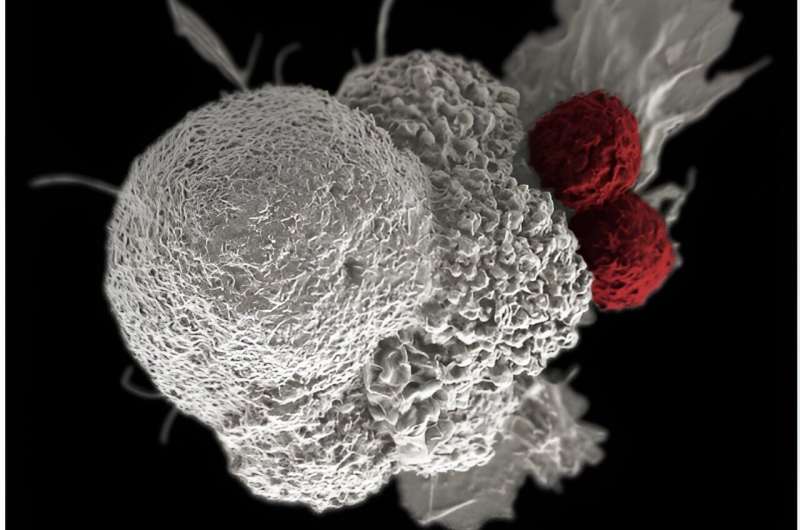This article has been reviewed according to Science X's editorial process and policies. Editors have highlighted the following attributes while ensuring the content's credibility:
fact-checked
peer-reviewed publication
trusted source
proofread
Researchers unravel the mechanisms of Epstein-Barr virus and host chromatin interactions in nasopharyngeal cancer

Nasopharyngeal carcinoma (or NPC) is a rare type of cancer affecting the epithelial tissue of the nasopharynx, the upper part of the throat behind the nasal cavity. Among the three main subtypes of NPC, non-keratinizing undifferentiated squamous carcinoma is endemic to the regions of Southern China and Southeast Asia, with a strong association with Epstein-Barr virus (or EBV) infection.
EBV, also known as human tumor virus, is a double-stranded DNA virus that is associated with various cancers, such as Burkitt lymphoma, T-cell lymphoma, and gastric cancer. EBV genomes mostly survive autonomously as episomes or extrachromosomal DNA (ecDNA) by attaching to the host chromosome in the nucleus.
Most of the EBV genome is repressed by methylation of their DNA and thus expresses limited genes. However, once EBV infects a host, it targets the host heterochromatin (a condensed form of DNA) and activates many latent host and viral genes that promote tumor formation.
"Enhancer infestation" or the activation of repressed enhancers (DNA-regulatory elements that activate transcription of a gene or genes) in the host genome, is one of the many ways of host genome rewiring by EBV. Although EBV-host cell interactions have been studied in many EBV-associated cancers, the cross-species genomic interaction and consequent chromatin changes in NPC have not been demonstrated.
In a study published eBioMedicine, Professor Atsushi Kaneda from the Graduate School of Medicine, Chiba University, Japan, and Associate Professor Melissa Jane Fullwood from the School of Biological Sciences, Nanyang Technological University, Singapore (NTU Singapore), have attempted to fill this knowledge gap by conducting collaborative research with their colleagues and scientists from Kanazawa University and Hamamatsu University School of Medicine, Japan, and from Duke-NUS Medical School, Singapore.
Explaining the motivation behind this study, Assoc Prof Fullwood explains, "I thought it would be very helpful if we could clarify the molecular mechanisms of cancer development and establish novel therapeutic strategies targeting not only resectable cancers but also intractable, metastatic, or recurrent cancers."
To undertake this examination, Dr. Harue Mizokami and colleagues conducted Hi-C, 4C-seq, CHIP-seq, and RNA-seq analyses to thoroughly understand the epigenomic rewiring and genetic dysregulation using C666-1 EBV (+)-NPC cell lines, NP69T immortalized nasopharyngeal epithelial cells, clinical NPC biopsy samples, and in vitro EBV infection in human EBV (-) cell lines HK1 and NPC-TW01.
In C666-1, it was observed that EBV genomes interacted with the host genome primarily in AT-rich, gene-poor regions, called the EBV-interacting regions or EBVIRs, that were located within the inactive B compartment of the host heterochromatin.
Furthermore, using Hi-C and CHIP-seq, they found that the EBV ecDNA may relax the inactive B compartments by activating enhancers in NPC cells. Moreover, the identified EBVIRs displayed significantly higher levels of histone protein alterations compared to NP69T, confirming genome restructuring. The above findings were also validated in clinical NPC biopsy samples.
Moreover, aberrant enhancer activation or genome rewiring resulted in dysregulated gene expression. Hi-C analysis identified H3K4me3(+) as one of the main genes affected by the EBV-host epigenomic alterations.
Confirming the above finding, RNA-seq analysis of NP69T and C666-1 cells found increased expression of 14 H3K4me3(+) genes in C666-1. EBVIRs altered the expressions of the target genes PLA2G4A, PTGS2, and CITED2 in NPC cells. Their upregulation contributed to the growth of cancer cells, while the knockdown of these genes showed a significant reduction of NPC cell growth.
Prof. Kaneda said, "Our findings will generate interest and create awareness among people on the ability of a virus to epigenetically alter our body's cells and cause diseases such as cancer. Moreover, the elucidated epigenetic mechanisms of cancer development will enable the development of novel cancer therapeutic strategies other than genome target therapy."
In summary, the study provides important insights into the mechanisms of virus-mediated tumorigenesis and paves the way for the development of novel therapeutic strategies.
More information: Harue Mizokami et al, Enhancer infestation drives tumorigenic activation of inactive B compartment in Epstein-Barr virus-positive nasopharyngeal carcinoma, eBioMedicine (2024). DOI: 10.1016/j.ebiom.2024.105057


















